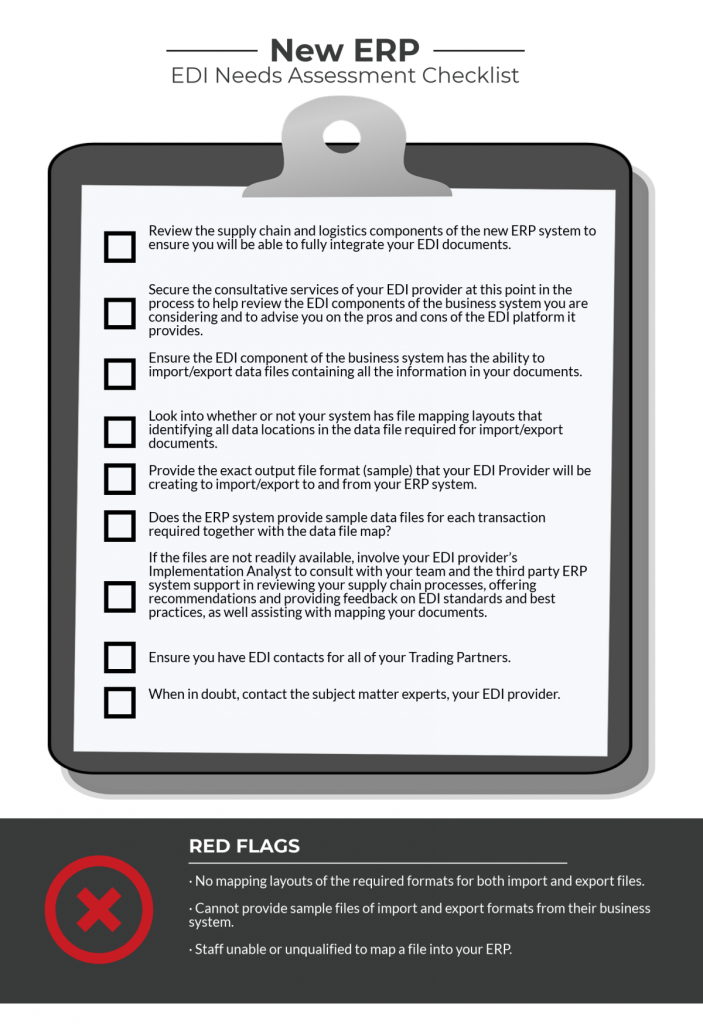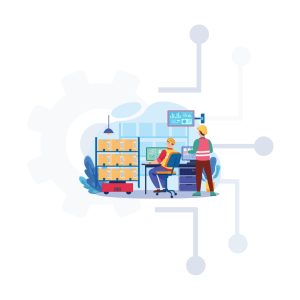Consulting your EDI provider early in the migration process can help you save thousands of dollars and avoid costly charge backs.
Introduction to EDI ERP System Integration
Many companies realize the importance of streamlining their supply chain processes – the myriad of benefits reaped from automating manual processes to better manage large volumes of paperwork, reduce hours of administrative duties, and reduce the potential for errors that could be encountered at any step of the supply chain process. Companies make it a priority to invest in a new ERP (Enterprise Resource Planning) software, a large investment for any size company. A common mistake companies, regardless of size, seem to make when preparing to move to a new ERP business system is not involving EDI experts earlier in the process. Most companies tend to place EDI at the bottom of the priority list.
The backbone of your business comes from your ability to fulfill customer orders and, in turn, receive prompt payment for those products. The most important factor in streamlining your supply chain process is ensuring you can integrate purchase orders received from your customers, as well as issue invoices as simply and efficiently as possible. A key component of establishing full integration is ensuring your import and export data files have mapping layouts available for your EDI solution provider to utilize when setting you up to trade with your customers. Commport’s EDI analysts run into issues when brought in too late in the game. Some of these issues arise from third-party IT professionals creating import and export files without knowledge of EDI standards and best practices.
Companies are then forced to pay additional third-party fees to revise layouts once they begin working with their EDI solution provider, resulting in a large amount of back and forth between your EDI provider and ERP system provider, thus causing your implementation fees to skyrocket. Consulting subject matter experts early in the process allows them to work together with your ERP system support team to create/generate the correct EDI or flat file (.csv, .xml etc.) output and input files in a single effort, resulting in large monetary and time savings.
When considering the move to a new ERP system, call your EDI solution provider to provide consultative services to ensure you are following EDI standards and best practices when setting up your supply chain internal processes. Our implementers’ extensive experience assisting with these migrations provides invaluable direction on simplifying and streamlining your processes and creating correct import and export files to best suit your business needs.
To aid you in selecting an ERP business system or planning your company’s migration to a new ERP software, Commport has created a checklist of items to review. We have also indicated the times at which investing in EDI consulting from your EDI provider is recommended and highlighted any red flags that should alert you to a possible software inadequacy.
9 Step Checklist to Integrate Your New ERP with Existing EDI System
1. Review
Review the supply chain and logistics components of the new ERP system to ensure you will be able to fully integrate your EDI documents.
2. EDI Consulting
Secure the consultative services of your EDI provider at this point in the process to help review the EDI components of the business system you are considering and to advise you on the pros and cons of the EDI platform it provides.
3. Import/Export
Ensure the EDI component of the business system has the ability to import/export data files containing all the information in your documents.
4. Mapping Layouts
Look into whether or not your system has file mapping layouts that identifying all data locations in the data file required for import/export documents.
5. File Format Samples
Provide the exact output file format (sample) that your EDI Provider will be creating to import/export to and from your ERP system.
6. Sample Data
Does the ERP system provide sample data files for each transaction required together with the data file map?
7. Best Practices
If the files are not readily available, involve your EDI provider’s Implementation Analyst to consult with your team and the third party ERP system support in reviewing your supply chain processes, offering recommendations and providing feedback on EDI standards and best practices, as well assisting with mapping your documents.
8. Trading Partner Contacts
Ensure you have EDI contacts for all of your Trading Partners.
9. Contact Us
When in doubt, contact the subject matter experts, your EDI provider.
Download this free EDI assessment checklist

Conclusion
The integration of Electronic Data Interchange (EDI) with Enterprise Resource Planning (ERP) systems represents a pivotal synergy in modern business operations. Through seamless data exchange, EDI streamlines communication among trading partners, fostering efficiency, accuracy, and cost-effectiveness in transactions. Meanwhile, ERP systems provide a centralized platform for managing various business functions, optimizing processes, and enhancing decision-making. By integrating these two technologies, organizations can achieve greater automation, visibility, and scalability throughout their supply chain and internal operations. As businesses continue to evolve in a digitally driven landscape, the integration of EDI with ERP systems will remain a cornerstone strategy for maximizing competitiveness and driving sustainable growth.
Learn more about commport specalized integration services
Commport Communications providing a wide range of innovative and comprehensive B2B solutions for Electronic Commerce since 1985. Book a free consultation today
Book NowDownload: EDI Buyers Guide
Unlock the full potential of your supply chain with our comprehensive EDI Buyer's Guide — your first step towards seamless, efficient, and error-free transactions
Frequently Asked Questions
Consulting with your EDI provider early in the ERP migration process is crucial because it allows for a seamless transition of EDI processes. It helps ensure that the new ERP system is compatible with your existing EDI setup, preventing disruptions, and avoiding costly errors or chargebacks.
Without involving your EDI provider early in the migration, you may encounter compatibility issues, data mapping errors, and disruptions in the flow of EDI transactions. This can lead to delayed order processing, chargebacks from trading partners, and additional costs to rectify the issues post-migration.
Early consultation with your EDI provider allows for a thorough assessment of your current EDI setup and ensures that the new ERP system is configured to seamlessly integrate with it. This proactive approach helps avoid costly rework, chargebacks, and potential business disruptions that may arise from misaligned systems.
Share details about your current EDI processes, trading partner requirements, and any specific customizations or configurations in your existing EDI setup. Additionally, provide information about the planned ERP system migration timeline and any unique considerations related to your business operations.
While involving your EDI provider later in the process is better than not involving them at all, early consultation is more effective. Early involvement allows for comprehensive planning, identification of potential issues, and proactive solutions, reducing the risk of disruptions and ensuring a smoother transition during the ERP migration.





